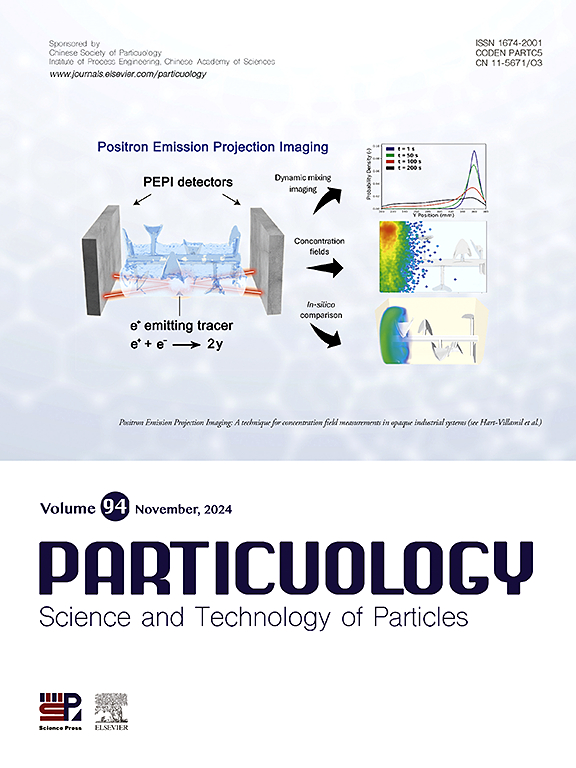Lithium was extracted from lithium-poor clay ores after short calcination by oxalic acid leaching
IF 4.1
2区 材料科学
Q2 ENGINEERING, CHEMICAL
引用次数: 0
Abstract
Limited research is available on lithium extraction technology for clay-type lithium deposits with relatively low lithium content. In this study, we investigated the effects of lithium extraction from lithium-poor clay ores using oxalic acid. The ore was first calcined and then fully mixed with solid oxalic acid powder, followed by water leaching. Raw material analysis revealed that the primary lithium-containing mineral was cookeite, with a lithium oxide content of 0.57%. The X-ray diffraction (XRD) patterns of the mineral phase before and after calcination at different temperatures revealed that the structure of the ores calcined at 300 and 400 °C was similar to that of the original ore. However, in the XRD patterns of the ore calcined at 500 °C, certain characteristic peaks of cookeite weakened or disappeared. Upon calcination at 600 °C, the hydroxyl group of cookeite was removed, amorphous phase of cookeite appeared, and maximum leaching yield was attained. Using response surface methodology optimization, the optimal calcination temperature and time; acid-to-ore and water-to-ore ratios; and reaction temperature and time were 600 °C and 2 min; 1:1 and 4 mL/g; and 95 °C and 6 h, respectively. The leaching yield under these optimal conditions was 92.33%. The results of this study revealed that lithium ions could be effectively extracted from mines using oxalic acid.

采用草酸浸出法从贫锂粘土矿石中提取锂
对锂含量相对较低的粘土型锂矿床的锂提取技术研究有限。在本研究中,我们研究了草酸对贫锂粘土矿石中锂的萃取效果。矿石先煅烧,然后与固体草酸粉充分混合,再进行水浸。原料分析表明,原生含锂矿物为库克矿,氧化锂含量为0.57%。不同温度下煅烧前后矿相的x射线衍射(XRD)图谱显示,300℃和400℃煅烧后的矿石结构与原矿石相似,而500℃煅烧后的矿石XRD图谱中,某些特征峰减弱或消失。在600℃下煅烧,去除羟基,形成无定形相,浸出率最高。采用响应面法优化,得到最佳煅烧温度和时间;酸矿比和水矿比;反应温度600℃,反应时间2 min;1:1和4ml /g;95℃,6 h。在此条件下,浸出率为92.33%。研究结果表明,草酸可以有效地从矿山中提取锂离子。
本文章由计算机程序翻译,如有差异,请以英文原文为准。
求助全文
约1分钟内获得全文
求助全文
来源期刊

Particuology
工程技术-材料科学:综合
CiteScore
6.70
自引率
2.90%
发文量
1730
审稿时长
32 days
期刊介绍:
The word ‘particuology’ was coined to parallel the discipline for the science and technology of particles.
Particuology is an interdisciplinary journal that publishes frontier research articles and critical reviews on the discovery, formulation and engineering of particulate materials, processes and systems. It especially welcomes contributions utilising advanced theoretical, modelling and measurement methods to enable the discovery and creation of new particulate materials, and the manufacturing of functional particulate-based products, such as sensors.
Papers are handled by Thematic Editors who oversee contributions from specific subject fields. These fields are classified into: Particle Synthesis and Modification; Particle Characterization and Measurement; Granular Systems and Bulk Solids Technology; Fluidization and Particle-Fluid Systems; Aerosols; and Applications of Particle Technology.
Key topics concerning the creation and processing of particulates include:
-Modelling and simulation of particle formation, collective behaviour of particles and systems for particle production over a broad spectrum of length scales
-Mining of experimental data for particle synthesis and surface properties to facilitate the creation of new materials and processes
-Particle design and preparation including controlled response and sensing functionalities in formation, delivery systems and biological systems, etc.
-Experimental and computational methods for visualization and analysis of particulate system.
These topics are broadly relevant to the production of materials, pharmaceuticals and food, and to the conversion of energy resources to fuels and protection of the environment.
 求助内容:
求助内容: 应助结果提醒方式:
应助结果提醒方式:


